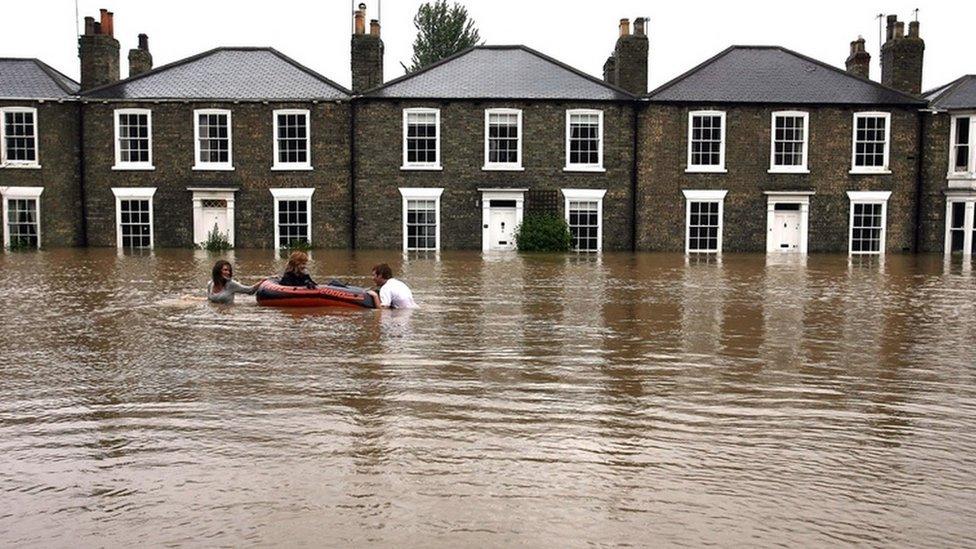The wettest summer on record - 10 years on from the 2007 floods
- Published
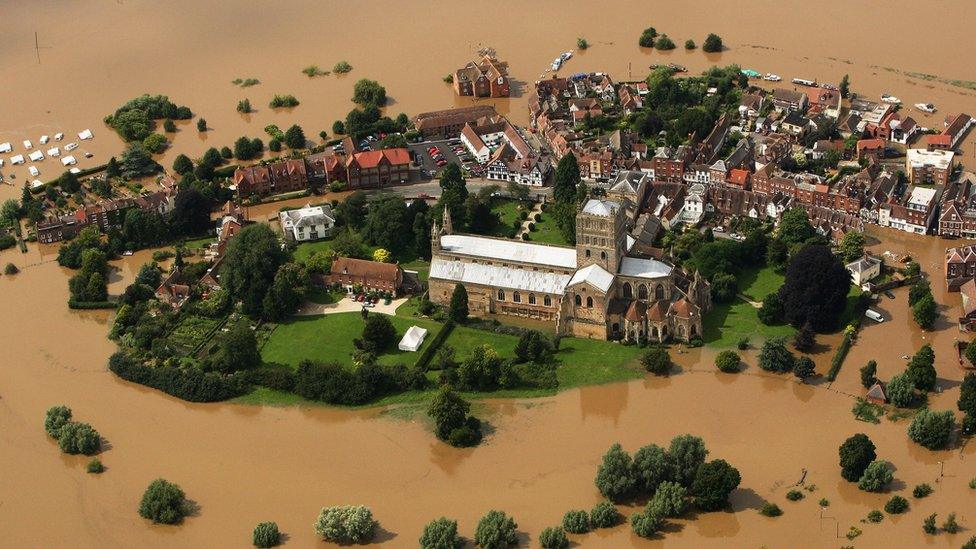
This photograph of Tewkesbury Abbey became a defining image of the 2007 floods
The summer of 2007 was the wettest on record. There was 414mm of rainfall across England and Wales from May to July - more than in any period since records began in 1766. Across Yorkshire and the Midlands, thousands of people were rescued, whole towns cut off and families forced to flee their properties.
In late July, Gloucestershire and Worcestershire became the latest parts of England to be inundated. Flooding left 48,000 homes without power for two days, and 10,000 motorists were stranded on the M5 overnight.
In Tewkesbury, the whole town became cut off and the RAF and Army were drafted in to help with the relief effort. Three people died.
An aerial photograph of the town and its famous abbey, depicting an island surrounded by a sea of brown water, became one of the defining images of that most sodden of summers.
Ten years on, the BBC revisits some of those caught up in the flooding.

'There was somebody coming up the road in a canoe'
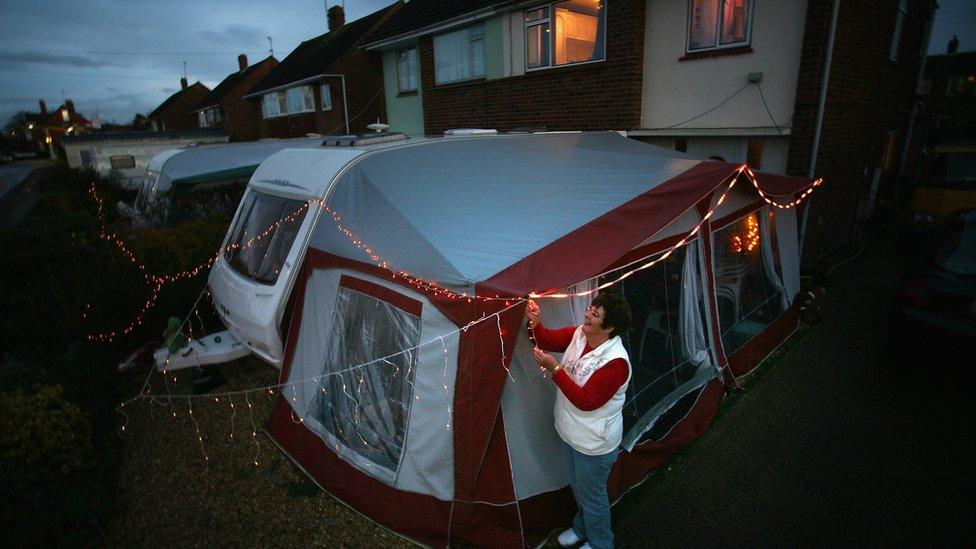
Sheila Heath ended up living in a caravan outside her flood-hit Tewkesbury home for seven months
The day - 20 July - had started off like any other.
But while at work, where she was a partner at a lettings firm in Cheltenham, Sheila Heath noticed the drains "bubbling" up with water from the torrential rainfall.
She knew immediately something was "seriously wrong", so she sent her staff home and tried to make her way back to Tewkesbury but was forced to abandon her journey and stay with a friend.
When she made it home the following morning, Mrs Heath, now 63, arrived to find her house had been inundated. She had to wade through waist-deep water to get to her front door.
"The whole area was like a lake," she recalls. "There was somebody coming up the road in a canoe; it was totally surreal."
It was six days before the water subsided, during which time the family lived at a nearby bed and breakfast.
With their house uninhabitable, they bought a caravan and pitched it outside, remaining there for seven months.

The Army transports emergency drinking water supplies in Tewkesbury on 24 July 2007
With many in the street doing the same, it became "like a caravan site", she said.
The cost of the damage - which was covered by the insurers - was £98,000, but many treasured possessions were irreplaceable.
"It was what we had built up all our married life, it was our home, all of our personal possessions," said Mrs Heath.
"It's still upsetting to this day.
"Everything you've built up over your life is just gone. All the photographs have gone, all the memories, gifts from the children, all your personal things have gone."

Sheila Heath says the flooding has had a lasting impact on her life

The summer 2007 floods - in numbers
Surface water and river flooding affected more than 55,000 homes and businesses across the country
7,000 people were rescued
17,000 families had to leave their homes
13 people died
Estimates made shortly after the floods put the total losses at about £4bn, of which insurable losses were reported to be about £3bn
Source: Environment Agency

'An icon of hope'
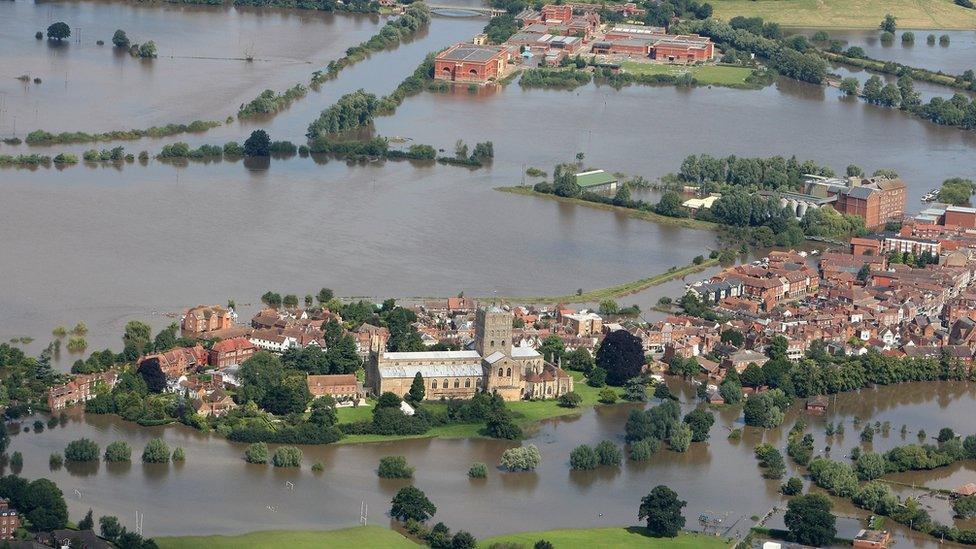
Tewkesbury was cut off on 22 July 2007
It was after saying afternoon prayers on 20 July 2007, that the Reverend Canon Paul Williams, the vicar of Tewkesbury Abbey, first became aware something unusual was happening.
"I noticed that the rain hadn't stopped all day," he said.
"I felt an eerie feeling so I went out up to the borough council and the mayor was there. He said 'we've been warned something serious is on the way and will we open the abbey to make sure it's a place of refuge'."
Drivers caught in the downpour slept in the abbey, with hundreds put up that Friday night.
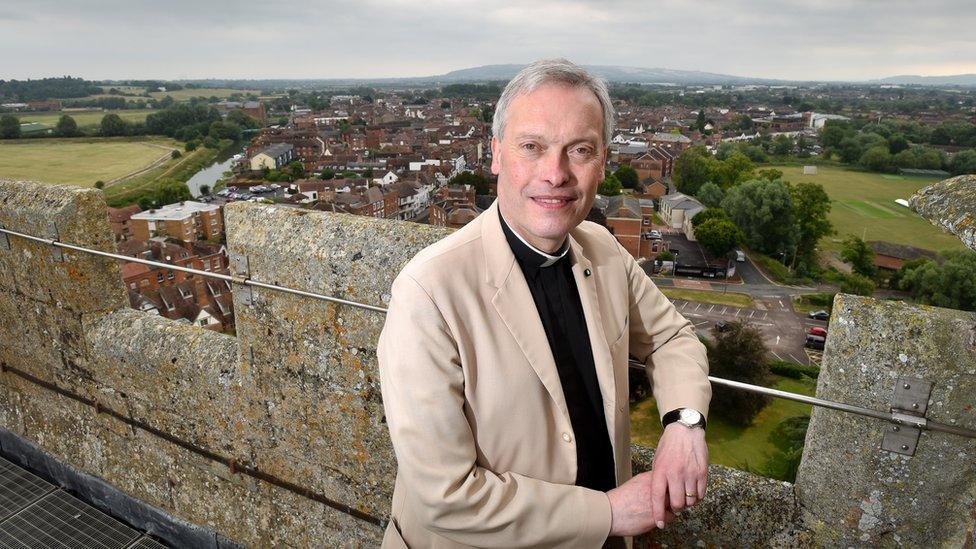
Paul Williams says the community is moving forwards following the flooding
"People were sleeping on kneelers, one family was wrapped in an altar cloth," he said.
"During that night lots of people were up and making sure that people using the abbey as refuge were looked after."
The rain had cleared on Saturday and those stranded were able to leave the abbey, which was even able to host a wedding ceremony.
But on Sunday 22 July the rivers broke.
"The abbey changed from being an ark to being an icon of resilience," said Canon Williams. "It was like a ship ploughing through the waters. It was an icon of hope."
It was that Sunday the famous photographs of Tewkesbury Abbey, standing proudly above the floodwater, were taken. They went on to become some of the most enduring images of that summer's floods.
"Someone once said it was one of the iconic images, like St Paul's in the Blitz, it's that type of image that will remain with people. You need icons to give you hope; the abbey gave us hope at that time," said Canon Williams.
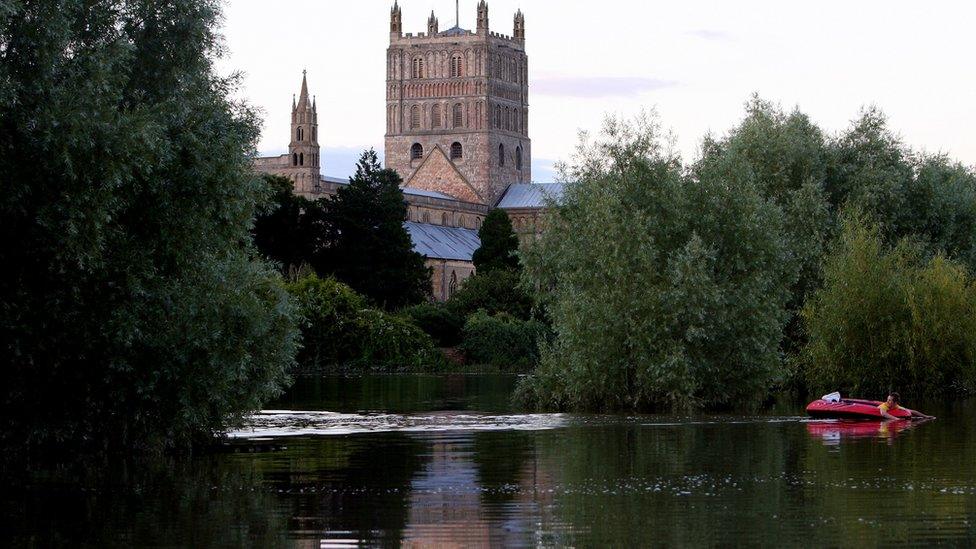
It looks like a lake - but this is actually Tewkesbury's flooded park
During the Gloucestershire town's short spell as an "island", the sense of community spirit shone through.
"There was an extraordinary feeling of camaraderie, particularly after the rivers broke - we were helping each other, making sure people were OK. There wasn't fear, there was respect.
"You couldn't get in or out. We were completely cut off. We got on with our business."
Remarkably, the abbey came away relatively unscathed.
The same could not be said for the rest of Tewkesbury.
More than 800 properties were flooded that July - largely by surface water and some smaller tributaries, before the Rivers Avon and Severn rose to record levels.
During the same period, the Mythe Water Treatment Works also flooded, leaving half the homes in Gloucestershire without water for 17 days.
And while it took years for the town to fully recover, Canon Williams says the community is "moving forward together".
"Of course that's part of our history, but we are looking to the future."


'It devastated the whole town'
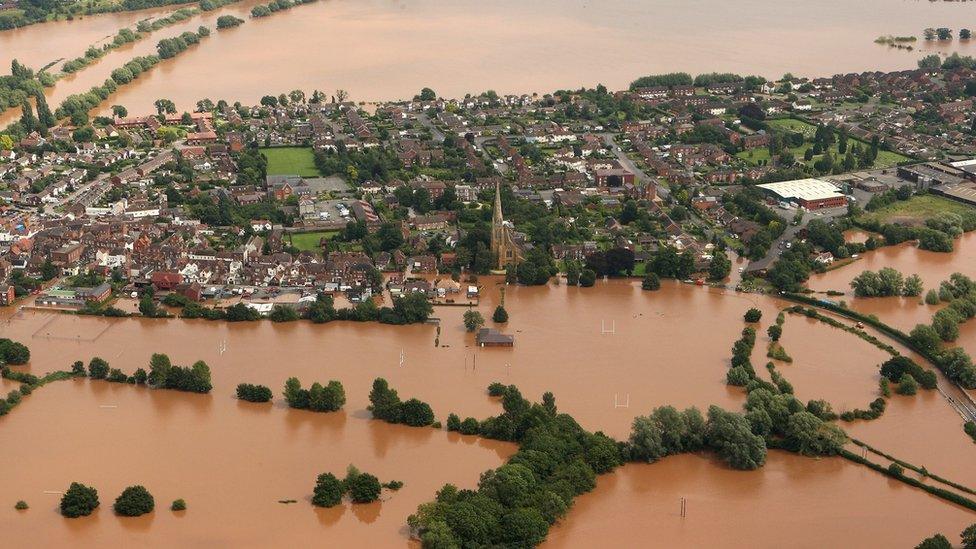
Upton upon Severn, which is about seven miles north of Tewkesbury over the border in Worcestershire, was also badly hit by the floods
Grahame Bunn, landlord of the Kings Head pub in Upton upon Severn, was gearing up for the town's blues festival when the rain started.
"The Environment Agency had said on the Wednesday that there was a possibility the river would flood, [but] this was the summer - we thought the Environment Agency was talking of their bottom," he said.
The Worcestershire town was supposed to be protected by temporary flood barriers, he said, and thousands of pounds worth of stock was sitting in his cellar.
"They said the barriers would go up on Friday, [but the] rivers started rising late Thursday."
It was too late to save his stock; the pub flooded waist-high with water.
His wife Claire, their son and three dogs were among those taken by boat through the floodwater.
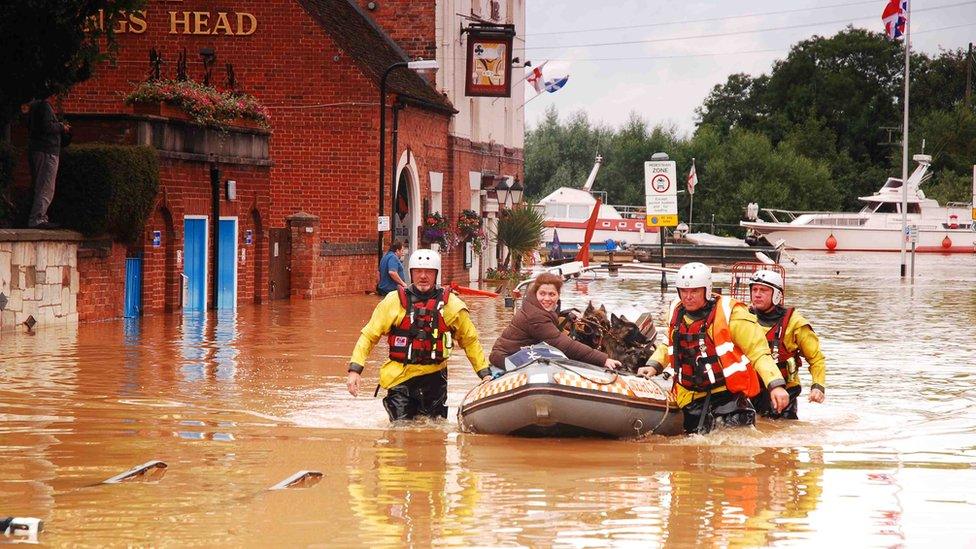
Grahame Bunn's wife Claire and their dogs were among those rescued by boat during the flooding in Upton upon Severn
The pub closed for four months and did not fully reopen until February 2008.
"It just devastated not only my business, but the whole of the town," said Mr Bunn, 58. "I don't think it has ever recovered."
While the Bunn family, who lived above the pub, were able to remain there as repairs were carried out, hundreds of thousands of pounds of damage was caused. Mr Bunn got a job working on the gravel barges on the river as the family had no income while the Kings Head was closed.
"We bought the pub in 2000 and knew there was a possibility it was going to flood," he said. "We had flooded many times before 2007, but this time it was different - we weren't able to reopen."
Mr Bunn, who now runs the nearby Ye Olde Anchor Inn, believes improved flood defences installed over the past decade mean the scenes of 2007 will not be witnessed again.
"Hopefully, the horrendous flooding of this town will be a thing of the past."

Claire Bunn and her husband Grahame, pictured behind the pub, in July 2017

BBC reporter Catherine Mackie
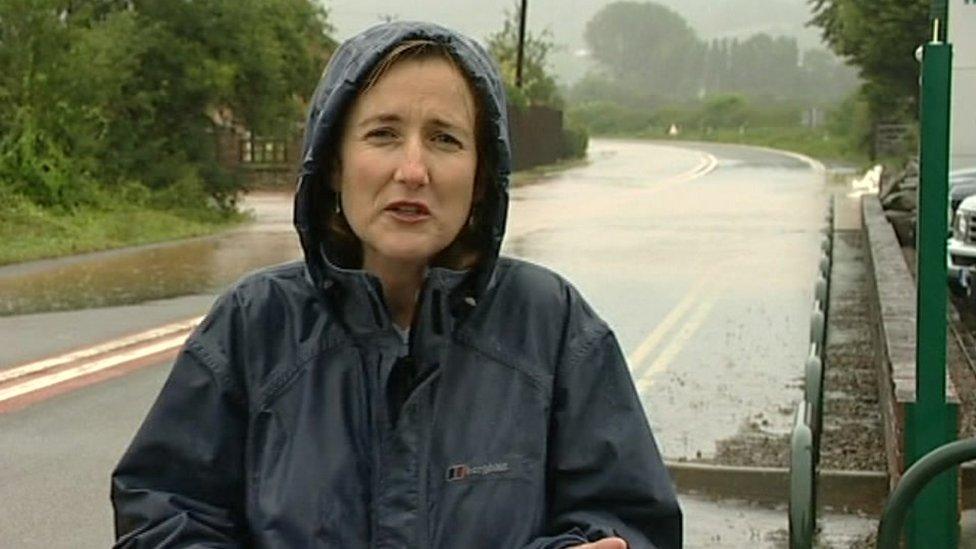
Catherine Mackie reporting from the scene of flooding in Herefordshire in the summer of 2007
Anyone who experienced the great flood of July 2007 has a story to tell.
I was soaked to the skin, shivering with cold and stranded in a pub car park in Herefordshire.
Inside the pub there was a small crowd of people who'd abandoned their cars on the roads-turned-rivers, resigned to spending an uncomfortable night with strangers.
Our satellite truck had died after the last live broadcast so I bunked down with the crew Andy and Brian in a caravan kindly donated by the landlady.
The rain continued to hammer down on the roof with the noise occasionally drowned out by Brian's snoring.

'People were scared for their lives'
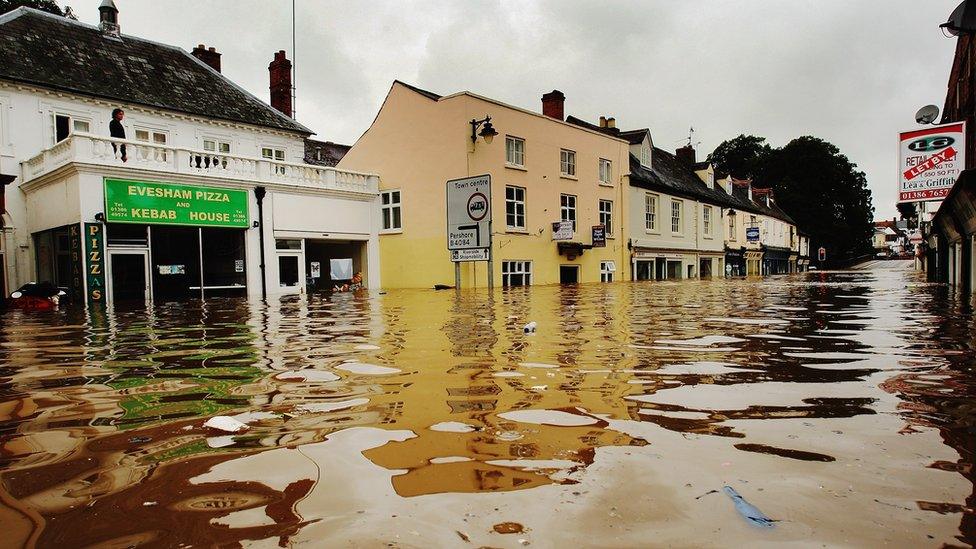
Homes and businesses were badly damaged by the floods in Evesham
Floods had been a fairly frequent occurrence in the south-west Midlands, with fire stations in Evesham, Hereford and Worcester equipped with boats to cope with water rescues.
But nothing could prepare crews for the rain of July 2007.
Firefighter Dave Hunt was on duty when his team received the call that Sedgeberrow, near Evesham, was flooding.
"There was a lot of rain so we were having a number of calls and then the call came in to Sedgeberrow," he said.
Two boats were sent to the village from Worcester fire station.

A water rescue is carried out in Evesham
Crews arrived to discover two men on the roof of a Ford Transit van.
"They were clinging on to the roof and the van was submerged," recalls Mr Hunt. "We launched the boats and the priority was to save them and bring them back to land."
Some rescues proved tricky, with crews unable to see house numbers or road names and, with lives on the line, decisions had to be made to prioritise those at greatest risk.
"We made several rescues of people and pets, there were about 90 flooded homes and we made rescues from 30 of the houses," added Mr Hunt.
"The most memorable rescue which we carried out was in liaison with the RAF helicopter of a pregnant lady and her toddler. They were trapped in floodwater.
"The RAF Sea King lowered and winched down. The toddler was rescued on a board. The winchman entered the bedroom and harnessed the pregnant lady and they both got winched up into the helicopter."
He described the floods as on a scale never seen before.
"People were scared for their lives [and] I would say a number of them were in danger of losing their lives," said Mr Hunt.
"We had never dealt with anything like it. That's the worst I've ever seen."
- Published25 June 2017
